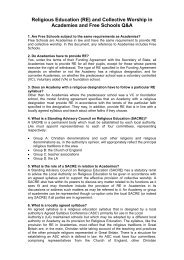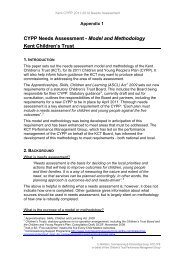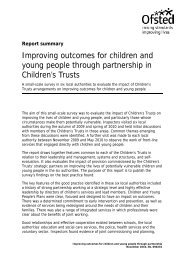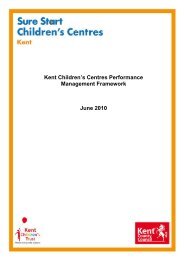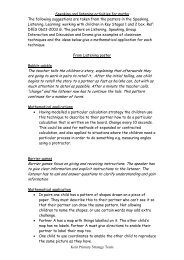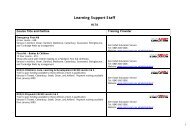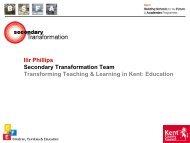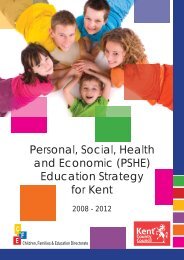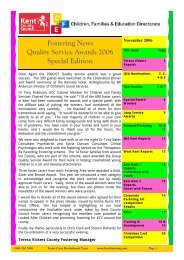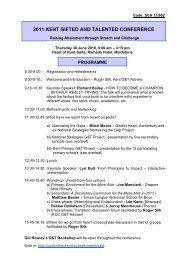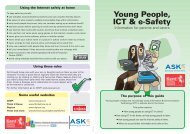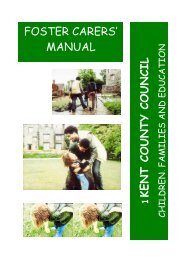Key Stage 1 - Kent Trust Web
Key Stage 1 - Kent Trust Web
Key Stage 1 - Kent Trust Web
You also want an ePaper? Increase the reach of your titles
YUMPU automatically turns print PDFs into web optimized ePapers that Google loves.
Level 5<br />
Pupils show understanding of a range of texts, selecting essential points and using inference and<br />
deduction where appropriate. In their responses, they identify key features, themes and characters and<br />
select sentences, phrases and relevant information to support their views. They retrieve and collate<br />
information from a range of sources.<br />
Level 6<br />
In reading and discussing a range of texts, pupils identify different layers of meaning and comment on<br />
their significance and effect. They give personal responses to literary texts, referring to aspects of<br />
language, structure and themes in justifying their views. They summarise a range of information from<br />
different sources.<br />
Writing:<br />
Level 2<br />
Pupils' writing communicates meaning in both narrative and non-narrative forms, using appropriate and<br />
interesting vocabulary, and showing some awareness of the reader. Ideas are developed in a sequence<br />
of sentences, sometimes demarcated by capital letters and full stops. Simple, monosyllabic words are<br />
usually spelt correctly, and where there are inaccuracies the alternative is phonetically plausible. In<br />
handwriting, letters are accurately formed and consistent in size.<br />
Level 3<br />
Pupils' writing is often organised, imaginative and clear. The main features of different forms of writing<br />
are used appropriately, beginning to be adapted to different readers. Sequences of sentences extend<br />
ideas logically and words are chosen for variety and interest. The basic grammatical structure of<br />
sentences is usually correct. Spelling is usually accurate, including that of common, polysyllabic words.<br />
Punctuation to mark sentences - full stops, capital letters and question marks - is used accurately.<br />
Handwriting is joined and legible.<br />
Level 4<br />
Pupils' writing in a range of forms is lively and thoughtful. Ideas are often sustained and developed in<br />
interesting ways and organised appropriately for the purpose of the reader. Vocabulary choices are often<br />
adventurous and words are used for effect. Pupils are beginning to use grammatically complex<br />
sentences, extending meaning. Spelling, including that of polysyllabic words that conform to regular<br />
patterns, is generally accurate. Full stops, capital letters and question marks are used correctly, and<br />
pupils are beginning to use punctuation within the sentence. Handwriting style is fluent, joined and<br />
legible.<br />
Level 5<br />
Pupils' writing is varied and interesting, conveying meaning clearly in a range of forms for different<br />
readers, using a more formal style where appropriate. Vocabulary choices are imaginative and words<br />
are used precisely. Simple and complex sentences are organised into paragraphs. Words with complex<br />
regular patterns are usually spelt correctly. A range of punctuation, including commas, apostrophes and<br />
inverted commas, is usually used accurately. Handwriting is joined, clear and fluent and, where<br />
appropriate, is adapted to a range of tasks.<br />
Level 6<br />
Pupils' writing often engages and sustains the reader's interest, showing some adaptation of style and<br />
register to different forms, including using an impersonal style where appropriate. Pupils use a range of<br />
sentence structures and varied vocabulary to create effects. Spelling is generally accurate, including that<br />
of irregular words. Handwriting is neat and legible. A range of punctuation is usually used correctly to<br />
clarify meaning, and ideas are organised into paragraphs.<br />
33



